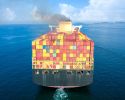New study: Ammonia the most cost-effective fuel of the future

Ammonia-powered vessels with dual-fuel systems will have a clear competitive advantage from the mid-2030s. In the short term, however, several other fuel alternatives remain competitive. This is according to a new study commissioned by the Global Maritime Forum.
The study, conducted by UMAS and the UCL Energy Institute, shows that dual-fuel ships capable of running on ammonia are well-positioned for the future. Under the guidelines of the IMO’s new Net Zero Framework, presented in April, these ships gain a clear competitive edge from the mid-2030s. The report, based on a Total Cost of Ownership (TCO) model, also indicates that other fuel alternatives—especially liquefied natural gas (LNG)—have a short-term advantage.
In the longer term, however, LNG-fueled ships face significant challenges. According to the report, LNG vessels will require either carbon capture or costly drop-in fuels such as bio-LNG, bio-marine gas oil, or e-LNG to avoid penalties—developments that weaken their long-term competitiveness. Combined with uncertainties around future fuel prices, the incentives to invest in LNG as a long-term solution are significantly reduced, the report states.
When it comes to ammonia, UMAS and UCL predict that blue ammonia—produced with natural gas and carbon capture—will be used initially, followed by e-ammonia during the 2040s. E-ammonia has the lowest cost per emission reduction among e-fuels and therefore requires the least support to become competitive. With the right incentive systems, e-ammonia could be a viable option as early as 2028.
“For shipping companies, ammonia has become an increasingly obvious choice,” says Dr. Tristan Smith, Professor of Energy and Transport at the UCL Energy Institute.
“However, significant uncertainty remains for e-fuel producers, who are still waiting for clear signals from the IMO’s policy process.”
The study urges ports to begin investing in ammonia infrastructure now, even though traditional fuels—particularly LNG—are expected to dominate the market during a transitional period. However, forecasts for LNG demand are uncertain, according to the study. The signal to biofuel producers is clearer: if they can offer competitive prices, there are good opportunities to meet growing demand, especially for drop-in solutions. Producers of conventional fuels can also expect to remain in the market for some time. Given the enormous size of the existing fleet, which will continue to need “oil,” demand for conventional fuels is expected to persist through 2040, the report predicts.
-
 Ny studie: Eldrivna pendelbåtar kan effektivisera Stockholms kollektivtrafik
Ny studie: Eldrivna pendelbåtar kan effektivisera Stockholms kollektivtrafik -
 EU: Sjöfartens utsläpp ökar
EU: Sjöfartens utsläpp ökar -
 Sociala relationer påverkar val av bränsle
Sociala relationer påverkar val av bränsle -
 Sjöfartens omställning kräver ”mjukare” påtryckningar
Sjöfartens omställning kräver ”mjukare” påtryckningar -
 Hon hade avtalad tid med Kapten ynkrygg
Hon hade avtalad tid med Kapten ynkrygg -
 Lighthouse omvärldsanalys 2025 – osäkerhet och tullar präglar sjöfarten
Lighthouse omvärldsanalys 2025 – osäkerhet och tullar präglar sjöfarten -
 Se seminariet Shipping in the Marine Environment
Se seminariet Shipping in the Marine Environment -
 Vad betyder egentligen de 90 procenten?
Vad betyder egentligen de 90 procenten? -
 Hålla där...
Hålla där... -
 Ny rapport: Klimatförändringarna ett hot mot de flesta större hamnar i världen
Ny rapport: Klimatförändringarna ett hot mot de flesta större hamnar i världen

